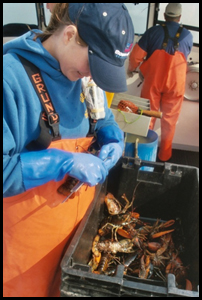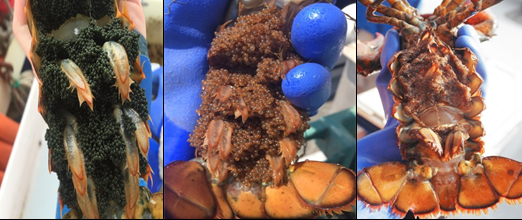Study Goal
The Maine Department of Marine Resources (DMR) sea sampling program began collecting at-sea catch/effort and biological information on legal and discarded lobsters from the near shore Maine lobster fishery in 1985. The sea sampling program was initiated at the request of industry, managers and scientists as there was a lack of information on the discarded portion of the lobster. Over the years, the program has expanded to become the largest at-sea sampling program for lobster in the northeast. Time-series of catch rates and biological data have been used in numerous investigations of width/length relationships, fecundity, size-at-maturity, sex ratio, geographic variation, growth, V-notch composition, and selectivity. Data from the sea sampling program contribute directly to the Atlantic States Marine Fisheries Commission (ASMFC) American lobster stock assessment.
Maine Lobster Management Zones (A-G) and federal Statistical Areas (511-513)
Project Objectives
- Collect catch & fishing effort information on the Maine lobster fishery to inform lobster stock assessments.
- Characterize discarded (v-notched, egg-bearing, or sublegal) lobsters.
- Maintain a positive relationship with the fishing industry by direct interaction.
- Improve industry participation in the lobster stock assessment process.
Study Design

Three sampling trips are completed for each lobster management zone (A-G) from May through November. The program has conducted winter sampling since 1999 with a goal at least one sampling trip in each statistical area from December through April (see above figure).
This program is voluntary and relies on the participation of interested fishermen. While aboard, the sea sampler collects general trip information including final catch weight and price as well as gear characteristics and bait type. Biological information recorded includes lobster carapace length, sex, cull status, v-notch condition (if present), egg development stage, molt status and extent of shell disease (if present).
Discarded lobsters (V-notched females, egg-bearing females, and sublegals) represent an important component of sea sampling data collection, since this information can only be collected at sea. In Maine, V-notching is taken very seriously and is an important component of the ASMFC lobster management plan. The DMR collects detailed information on discarded lobsters (see pictures of v-notches and egg stages are below).

Illegal notches that would be seen on the tail flipper to the right of center: (from left to right) new manmade notch, old manmade notch, new natural mutilation, new missing flipper

Egg stage categories: (from left to right) Stage 1: recently extruded "black" eggs, State 2: eyed eggs (black or turquoise specks) and Stage 3: ?egging off?
At the end of the sampling season trip reports are sent to each fisherman who hosted a sea sampler, providing the fishermen with confidential catch and effort information from that sampling day as well as the overall results from the sampling season. Results are disseminated to the industry through zone council meetings, The Fishermen?s Forum, and through the DMR newsletter.
2023 monitoring program update (PDF file, 4 pages)
Sea Sampling Information Brochure (PDF file, 2 pages)
Contacts
The DMR relies on volunteer lobsterman to help collect these important data. If you are interested in taking a sea sampler, please contact: